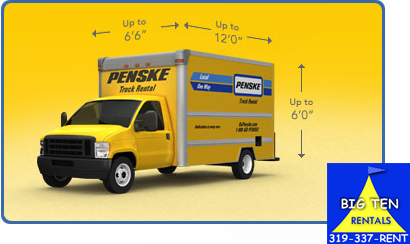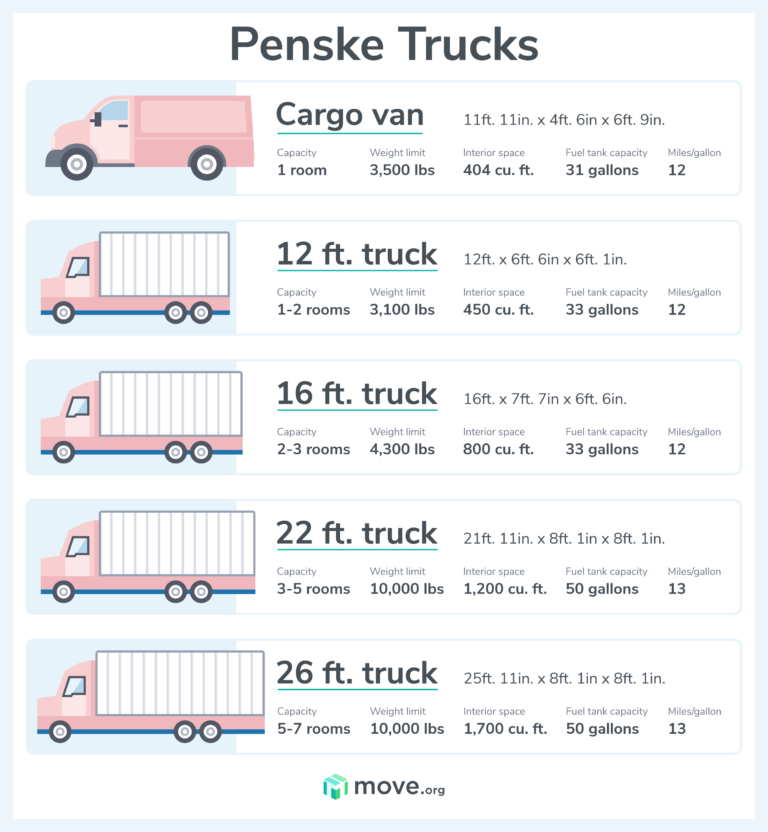Exterior Dimensions Of A Penske 12ft Box Truck: A Comprehensive Guide types.truckstrend.com
Renting a box truck for a move, a business delivery, or a special event requires more than just knowing its cargo capacity. While the "12ft" in "Penske 12ft Box Truck" refers to the length of its interior cargo space, understanding the truck’s exterior dimensions is paramount. These often-overlooked measurements dictate where you can drive, park, and maneuver, directly impacting the safety, efficiency, and overall success of your journey. This comprehensive guide will delve into the critical exterior dimensions of a Penske 12ft box truck, offering practical insights and actionable advice to help you navigate with confidence.
Understanding the Importance of Exterior Dimensions
Exterior Dimensions Of A Penske 12ft Box Truck: A Comprehensive Guide
The Penske 12ft box truck is a popular choice for smaller moves, apartment relocations, and local deliveries due to its manageable size and ample cargo room. However, its exterior footprint is significantly larger than a standard passenger vehicle. Ignoring its overall length, width (especially with mirrors), and height can lead to costly damages, dangerous situations, and significant delays. From navigating low bridge clearances and tight city streets to finding suitable parking and accessing loading docks, every aspect of your journey is influenced by these vital measurements. Knowing them beforehand allows for meticulous planning, safe execution, and a stress-free experience.
Key Exterior Dimension Categories
To fully grasp the physical presence of a Penske 12ft box truck, it’s essential to understand the different categories of its exterior dimensions:
-
Overall Length: This is the measurement from the very front bumper to the very rear of the truck, including any rear bumpers or tail lights. It dictates how much space you’ll need for parking, turning, and even fitting onto a ferry or into a garage (though most residential garages won’t accommodate it).

Overall Width (with Mirrors): This measurement is taken from the outermost edge of one side mirror to the outermost edge of the other. It’s crucial for navigating narrow lanes, driveways, toll booths, and ensuring you don’t scrape against parked cars or obstacles. Many drivers forget to account for the mirrors, which significantly extend the truck’s actual width.
-
Overall Height: Measured from the ground to the very highest point of the truck, typically the top of the cargo box. This is arguably the most critical dimension to monitor, as it determines whether you can pass under bridges, tunnels, drive-thru awnings, parking garage entrances, or even low-hanging tree branches.
-
Wheelbase: The distance between the centers of the front and rear axles. While not directly an "exterior" dimension in the sense of clearance, it significantly influences the truck’s turning radius and stability, especially during turns or when encountering uneven terrain. A longer wheelbase generally means a larger turning radius.
-
Ground Clearance: The distance from the lowest part of the truck’s undercarriage to the ground. This is important for preventing scrapes when going over speed bumps, uneven terrain, or steep driveways.


Detailed Breakdown of Penske 12ft Box Truck Exterior Dimensions
Penske provides specific dimensions for its rental fleet to ensure customers can plan accurately. For the 12ft box truck, while minor variations might exist between specific models or manufacturing years, the following are the typical and widely accepted exterior dimensions:
- Overall Length: Approximately 20 feet (6.1 meters)
- Overall Width (without mirrors): Approximately 8 feet (2.44 meters)
- Overall Width (with mirrors): Approximately 8 feet 6 inches (2.59 meters)
- Overall Height: Approximately 9 feet 6 inches (2.90 meters)
- Ground Clearance: Approximately 6.5 inches (16.5 cm)
- Ramp Length: Approximately 7 feet (2.13 meters) (Important for loading/unloading logistics)
It’s vital to remember that the "12ft" designation refers to the interior cargo box length, which is typically 12 feet long, 7 feet 6 inches wide, and 6 feet 10 inches high. The exterior is always significantly larger.
Why Exterior Dimensions Matter: Practical Implications and Benefits
Understanding these dimensions offers a multitude of practical benefits and insights:
-
Maneuverability: A 20-foot long vehicle with a specific wheelbase will have a significantly larger turning radius than your car. This affects how you approach turns, navigate intersections, and perform U-turns. Knowing the dimensions allows you to anticipate these needs and plan your maneuvers accordingly, preventing multi-point turns in busy areas.
-
Route Planning and Navigation: This is where exterior dimensions are most critical.
- Height: You must be acutely aware of bridge clearances, tunnel heights, and low-hanging structures (e.g., car wash entrances, drive-thrus, building overhangs, tree branches). A truck-specific GPS or a pre-planned route using online mapping tools that highlight height restrictions is invaluable.
- Width: Narrow streets, construction zones, and tight residential areas can become impassable if your truck is too wide. Even toll booths and drive-thrus can be tricky.
- Length: Tight cul-de-sacs, congested city blocks, and specific delivery locations might be challenging to navigate or park in.
-
Parking Considerations: A 20-foot vehicle will not fit into a standard parking space length-wise. You’ll often need to find two consecutive spaces, park in designated truck parking areas, or utilize street parking where permitted and safe. The overall width, including mirrors, also means you’ll need more room to open doors and avoid hitting adjacent vehicles.
-
Loading and Unloading Access: While interior dimensions dictate what you can carry, exterior dimensions determine if you can even get to your loading or unloading point. Can the truck fit down your driveway? Is there enough space to back up to a loading dock? Will the ramp deploy effectively without obstruction?
-
Legal and Safety Compliance: Many jurisdictions have specific regulations regarding vehicle size on certain roads, especially in residential areas or historic districts. Ignoring these can lead to fines. More importantly, exceeding clearance limits poses a severe safety risk, potentially causing accidents, structural damage, and injuries.
-
Cost Implications: Some tolls are calculated based on vehicle length or axle count. Ferry fees are almost always dependent on vehicle length. Unexpected detours due to clearance issues can also lead to increased fuel costs and time.
Tips for Driving and Planning with a 12ft Box Truck
- Measure Your Destination: Before you even pick up the truck, measure any critical points at your origin and destination: driveway width, garage opening height (if you plan to pull close), and any known low overhangs.
- Confirm with Penske: While the provided dimensions are standard, it’s always a good idea to re-confirm the exact measurements with Penske when you pick up your specific truck, as minor model variations can occur.
- Use a Truck-Specific GPS: Standard car GPS systems do not account for vehicle dimensions. Invest in or use an app that provides truck-specific routing, avoiding low bridges, weight-restricted roads, and tight turns.
- Pre-Plan Your Route: Even with a truck GPS, review your route on a map beforehand. Look for potential hazards like low clearances or extremely narrow roads, especially in residential areas or older parts of town.
- Be Mindful of Mirrors: Always account for the extended width provided by the side mirrors, especially when passing other vehicles, going through narrow openings, or parking.
- Practice Driving: If you’re new to driving a larger vehicle, take a few minutes in a large, empty parking lot to get a feel for the truck’s size, turning radius, and braking distance. Practice backing up and turning.
- Utilize Spotters: When backing up or navigating tight spaces, have a trusted person outside the truck guide you. Establish clear hand signals beforehand.
- Drive Defensively: Allow more following distance, anticipate stops, and take turns wider than you would in a car. Blind spots are larger in a box truck.
Challenges and Solutions
- Challenge: Low Clearance Accidents.
- Solution: Prevention is key. Always heed height restriction signs. If in doubt, stop, get out, and measure. Use a truck-specific GPS. When uncertain, find an alternative route, even if it adds time.
- Challenge: Tight Parking and Maneuvering.
- Solution: Seek out larger parking spaces (e.g., at the end of rows, in truck-friendly lots). Consider parking further away from your destination and walking. Use a spotter when backing up. Make wide turns to avoid curbing tires or hitting obstacles.
- Challenge: Unexpected Obstacles (e.g., low tree branches, power lines).
- Solution: Maintain a vigilant eye, especially on residential streets. Drive slowly and be prepared to stop. If an obstacle is unavoidable, assess if there’s enough clearance or if you need to find an alternative path.
Summary of Exterior Dimensions and Their Implications
Here’s a concise overview of the Penske 12ft box truck’s exterior dimensions and their practical considerations:
| Dimension | Approximate Value | Primary Implication/Consideration |
|---|---|---|
| Overall Length | 20 ft (6.1 m) | Parking space requirements, turning radius, ferry/tunnel length limits. |
| Overall Width | 8 ft (2.44 m) | Narrow lanes, driveways, toll booths, general road width. |
| Overall Width (w/ Mirrors) | 8 ft 6 in (2.59 m) | Critical for tight spaces, passing, avoiding side scrapes. |
| Overall Height | 9 ft 6 in (2.90 m) | Crucial for bridges, tunnels, overhead clearances, parking garages. |
| Ground Clearance | 6.5 in (16.5 cm) | Speed bumps, uneven terrain, steep driveways, loading ramps. |
| Ramp Length | 7 ft (2.13 m) | Ease of loading/unloading, space needed behind truck for ramp deployment. |
Conclusion
The exterior dimensions of a Penske 12ft box truck are far more than just numbers; they are the blueprint for a successful and safe rental experience. By taking the time to understand the truck’s length, width, and especially its height, you empower yourself to plan smarter routes, avoid costly mistakes, and navigate with confidence. Knowledge of these critical measurements is your best tool for ensuring that your belongings arrive safely and that your journey is as smooth and efficient as possible. Don’t just focus on what fits inside; know what fits on the road.
Frequently Asked Questions (FAQ)
Q1: Does the "12ft" in "Penske 12ft Box Truck" refer to the interior or exterior dimensions?
A1: The "12ft" refers to the approximate length of the interior cargo space. The exterior dimensions, including the cab and bumpers, are significantly larger.
Q2: Are all Penske 12ft trucks exactly the same exterior dimensions?
A2: While Penske strives for consistency, minor variations (e.g., a few inches) can occur between different model years or specific truck manufacturers within their fleet. Always re-confirm the exact dimensions when picking up your rental if precision is critical.
Q3: Can I park a Penske 12ft truck in a standard car parking space?
A3: Length-wise, a 20-foot truck will typically extend beyond a standard parking space, often requiring two spaces. Width-wise, it will fit, but the extended mirrors mean you’ll need to be careful not to hit adjacent vehicles or parking lines. It’s often best to seek out larger, designated truck parking or street parking where allowed.
Q4: What’s the most critical exterior dimension to watch out for when driving a box truck?
A4: The overall height is generally the most critical dimension. Failing to account for low bridges, tunnels, parking garage entrances, or overpasses can lead to severe accidents, vehicle damage, and personal injury. Always pay attention to clearance signs.
Q5: Do I need a special license to drive a Penske 12ft box truck?
A5: In the United States, a standard Class D (regular) driver’s license is typically sufficient to operate a Penske 12ft box truck, as its Gross Vehicle Weight Rating (GVWR) is usually below 26,001 pounds, which is the threshold for requiring a Commercial Driver’s License (CDL). However, always check local and state regulations as they can vary.
